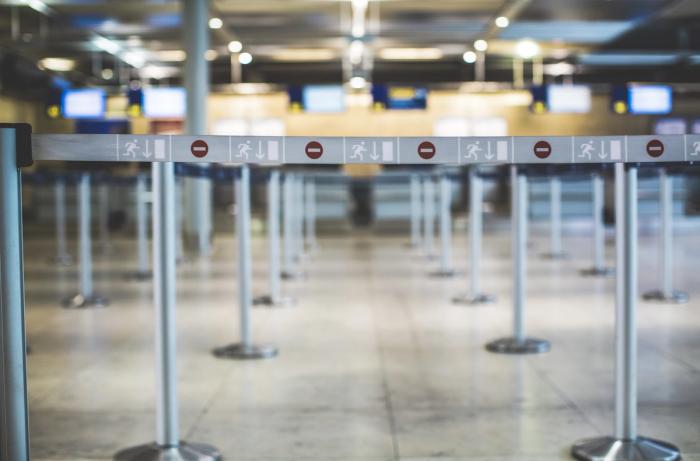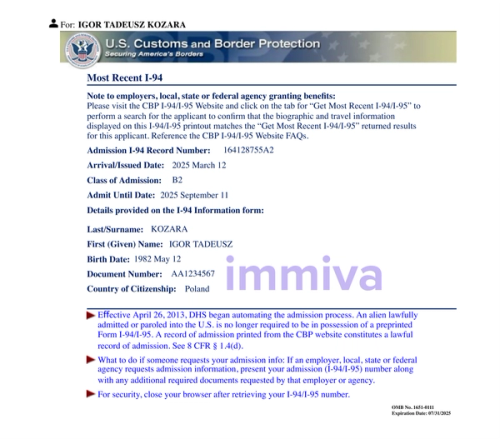Published: Jul 10, 2025
I-94 Arrival/Departure Record - Explained
What I-94 Form is, why it matters, and how not to mess it up when you fill applications with USCIS
By Alicja
Ever landed in the US and thought, "Am I missing some paperwork?" Or worried if you've overstayed because no one stamped anything obvious? You're not alone. The I-94 arrival/departure record trips up tons of visitors, students, and even folks here on work visas.

Back in the day, you would receive a small piece of paper with your arrival information at the border crossing; nowadays, it is mostly (if not entirely) digital. Thus, often folks don't even know they received one.
Worst part: a border agent made a mistake while issuing you one? You might have problems if you try to change your immigration status or apply for an EAD.
Let's break it down in plain English so you know exactly what it is, why you should care, and how to keep your stay stress-free.
What exactly is the I-94?
Think of the I-94 as your official check-in and check-out record for the US It shows when you arrived, how long you're allowed to stay, and when you need to leave.
Why does the I-94 matter so much?
Many people mistakenly believe that the visa stamp in their passport determines how long they can stay. Nope. The visa is like a key to get you in the door. The I-94 is what tells you how long you're allowed to stay in the US and under which visa category you were admitted.
For example, your tourist visa might be valid for 10 years, but your I-94 might only give you 6 months to stay each time you enter.Overstay that date, and you're officially out of status, meaning big headaches if you ever want to come back.
This is why checking your I-94 is essential every time you enter the US.
How to obtain your I-94?
Easy! It's all online.
- Simply visit https://i94.cbp.dhs.gov and click "get most recent I-94/I-95".
- Enter all required personal details i.e. First name, last name, date of birth, citizenship and the passport number, you used to enter the US).
- You'll see your most recent I-94, which includes the exact date you need to leave.
- Click on print to print it or to save it as a PDF.
It's surprisingly common for the system to have errors—wrong dates, misspelled names—so catch it early and you can get it fixed at a CBP office.
 Example of I-94 Form Arrival-Departure - by Immiva
Example of I-94 Form Arrival-Departure - by ImmivaWho gets an I-94 and when?
- Most nonimmigrants: If you're coming to the US on a tourist visa (B1/B2), student visa (F-1), work visa (H-1B, L-1, etc.), or most other temporary visas, you'll get an I-94 each time you arrive.
- At the port of entry: The I-94 is created when you go through Customs and Border Protection (CBP), either electronically (by air or sea) or on a paper card (often at land borders).
- Every new entry: Even if you've visited the US before, you get a new I-94 every time you arrive, each with its own expiration date that starts the clock on how long you can stay.
Who doesn't get an I-94?
- US citizens and green card holders: They don't need an I-94 at all.
- Visa Waiver Program (VWP) travelers: Individuals from countries such as the UK, France, Japan, and others, who travel under ESTA, don't receive an I-94.
- Most short-term Canadian visitors: Canadians generally don't receive an I-94 if they're coming for brief visits without a specific visa, although they will if they enter under statuses such as TN or certain work classifications.
What if there's a mistake on your I-94?
Maybe the officer typed in the wrong date, or your name's missing a letter. It happens. It happened to me, it happened to a number of my classmates. If it does, you can visit a local CBP deferred inspection site (usually at a big airport), and they'll fix it. Don't wait—once that date passes, it's a whole lot harder to sort out.
What about extensions or changes?
If you're loving life in the US and want to stay longer—say, to switch from tourist to student, or extend your current status—you'll generally need to file paperwork with USCIS before your I-94 expires.
That's key: you must be in status (meaning, your I-94 hasn't expired) to change or extend.
Conclusion: Keep it simple, keep it legal
The I-94 might feel like a boring piece of bureaucracy, but it's the most important document you've probably never thought about.
Checking your I-94 after every entry, making sure the info is correct, and leaving or filing the right paperwork before it expires can save you a ton of stress (and money) down the road.
If you're uncertain or things seem incorrect, it's a good idea to consult an immigration professional or use a service like ours at Immiva, which helps keep your paperwork on track. You don't want your American adventure to be interrupted by a small mistake.
About Immiva
Resources
Disclaimer: Simple Immi LLC dba Immiva is not a lawyer or a law firm and does not engage in the practice of law, provide legal advice, or offer legal representation. The information, software, services, and comments on this site are for informational purposes only and address issues commonly encountered in immigration. They are not intended to be a substitute for professional legal advice. Immiva is not affiliated with or endorsed by the United States Citizenship and Immigration Services (USCIS) or any other government agency. Your use of this site is subject to our Terms of Use.
Copyright © 2025 immiva.com (Simple Immi LLC dba Immiva)